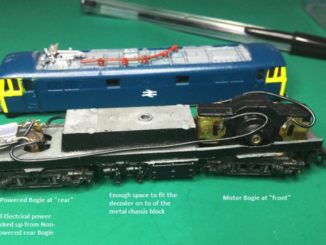
User:Colin – Licence CC BY-SA 2.0
Introduction
This is intended to be a short series of articles which it is hoped will cast a little light on the curious world of commercial bids and tenders. While the focus is on the supply of industrial services as this is my area of knowledge the principles apply right from the smallest of submissions to the largest, though the level of detail will vary.
The intention is to provide those curious as to “why does everything cost so damned much? Especially when a government agency is involved?”. For reference I have not submitted tenders for government work, but I have submitted tenders as a sub-contract supplier to those who are.
Setting the Scene
For the purposes of this series of articles we will consider a fictional company that has a range of fictional products to fictional customers, any similarity to any real companies, organisations or individuals is entirely coincidental as this draws on a range of experiences, good, bad and ugly from several years of working as a commercial Bid Manager, a role about which more will be explained later.
The exact nature of the products need not concern us here, but assume we are talking items that individually cost roughly £1,000,000 give or take and may be bought and sold in quantities ranging from roughly 20 or so up to roughly 400 or so. Additionally there are additional post sales service requirements to support these products.
This scale provides a good mix of both scale, which translates into the effort the customer picks in getting the right product without getting into the truly ridiculous scales.
About the Author
I’m just a little leopard in a seemingly crazy urban jungle sometimes, I have however worked as a Bid Manager and Senior Bid Manager for a company providing services to existing products and supporting a Bid Manager on projects such as will be considered here for a number of years, with mixed success.
If anyone takes all that is written here as gospel they should consider seeking professional help, and then I would kindly request if such is successful, can you pass along a recommendation?
In the Beginning
Firstly we should consider a few basic definitions that with luck may make that which follows easier to follow.
We shall begin with the various organisations concerned and the key roles involved within each – note when I refer to “role” this doesn’t translate to “individual”, many of these roles will involve several individuals, and several could be combined – it gets somewhat confusing, which causes a range of interesting challenges, and by challenges I mean idiocy that causes you to bang your head on the wall.
The Customer
The is the organisation that has a problem they wish to be resolved, note the language, they don’t want to buy anything, they just have an issue they wish to be solved and are aware this may involve buying something. They do not always know what they want, and often don’t, in several cases you will find they don’t really understand the problem either.
Customer Tendering Team
Aka “the clueless”, this definition is not entirely fair however when combined with the Suppliers Sales Team definition will make more sense.

Tricia Hall – Licence CC BY-SA 2.0
These individuals are responsible for putting together proposals to their own purchasing and senior management teams for solutions to problems, be that buying a product, a service or whatever.
The Supplier
This is your organisation, with a range of first rate, honest guv’ and no mistaking products and services that customers just can’t seem to understand the brilliance of.
Sales Team
Aka “the dishonest”, again this definition is not entirely fair but when you think of ‘sales’ as a department you tend to picture a sack full of weasels.

big-ashb – Licence CC BY 2.0
These individuals job is to hook a customer and, by fair means or foul, win the order. They do not however do a huge amount of the actual leg work during the actual tendering process, their role is however critical before this. They are the suppliers eyes and ears in the industry, tasked with finding out what potential work is likely and helping to “guide” customer expectations towards their own product lines.
This is a very skilled job when done properly, but tends to attract individuals you wouldn’t lend money to, at least not twice.
Commercial Team
These are the contracts people, not specifically lawyers but will often have basic legal skills within the team and will work with lawyers. Their primary function is to protect the supplier from the customer, while the weasels will promise the earth, these are the guys who add “terms and conditions apply” and then produce a document the devil herself would balk at.

su neko – Licence CC BY-SA 2.0
Typically this team will also handle the process of turning the cost of the project into the price of the project a process which can be somewhat involved and will be covered later but for now can be essentially considered thus:
Cost: This is how much money you will have to pay out
Price: This is how much money you can extract from the customer
Note there is no relationship between these, oh yes some people will talk of “markups” but thats the wrong way to go about it, the “price” from the suppliers point is “the maximum we can get away with and still secure the contract”
Hence the battle between the clueless (who don’t know what the costs are) and the dishonest (who will play a game to make Fagan wince).
Bid Team
This is where the poor Bid Manager lives, a true superhero in our time who adopts a role similar to a circus ring master keeping the weasels in clown suits away from the tigers of commercial and the lions of legal and stopping both mauling the customers to the extent they never come back.

Split the Kipper – Licence CC BY 2.0
The bid teams job is to take what the customer says they want, find out what they actually want (you could use ascertain here, but if you do I will hunt you down), take what the company actually offers and find a way to make it seem to fit while shaping the customers desires such that they will be satisfied with it. Then square the circle of the commercial position of the organisation (which the customer will run away from) and the commercial position of the customer (which the supplier will laugh at)
Project Team
Aka “the fools”, these are the poor saps who will have to deliver what the weasels told the customer they were getting, within the confines of what the commercial team give them in terms of financial resources while living with the assumptions made by the bid team..

Pierre (Rennes) – Licence CC BY 2.0
If at the end of the day the customer isn’t calling for their heads on spikes its broadly a successful project, doubly so if you can sell the customer something again.
Sub Contractors
These are the people you will perhaps involve at various stages of the actual project. Note the whole cycle repeats, though with your organisation now in the role of the clueless.
Life gets even more interesting when this is a different part of your own organisation.

Oleg Sidorenko – Licence CC BY 2.0
Next we can consider a few more terms that will occur in this series, note these can be called different things but I will try to be consistent here, no promises like.
Request For Information (RFI)
This is a document put out by a customer when they are considering a project, it does not generally require a vast amount of detail or specific prices (though they do usually ask for a price). This is a customers way of getting a rough idea of solutions to problems.
For example, they may actually present the problem and ask for help solving it, or they may have done some ground work into potential solutions and have sent RFI to various organisations to request details of specific products.
Pre-Qualification Questionnera (PQQ)
This is a document requesting information about your organisation, for example how many employees do you have? when were you established? what was your turnover in the last three years? what percentage of your employees are BAME or female or of unknown gender?
How many children in 3rd world countries have you exploited? etc.
Most of this, indeed 95% typically is boiler plate stuff, the bits that actually matter tend to be your turnover (because they want to know you are likely to still be around in a few years) and any previous experience in the relevant areas (so they know if you have done this before).
The purpose of this is to take say a dozen potential suppliers and reduce this to a more manageable four to six for the actual tender stage.
Request for Proposal (RFI) or Invitation To Tender (ITT)
Basically the same, though some companies use them differently. this is basically the customer putting out a specification they wish to purchase a solution against and a list of questions they wish to be answered so they can evaluate and pick the supplier of choice.
Note the specification in the ITT is seldom the one to be finally delivered, as goalposts do tend to move, often with considerable speed. However this is the specification the customer will evaluate.
If you are lucky the ITT will include scoring criteria….
Thats it for this part, as you can see there is perhaps slightly more going on behind the scenes here, but consider it like this. If you are thinking say of buying a new car you will go through something similar in a slightly different way:
- “RFI” – look at brochures, the internet etc to find out whats about, likely costs and specifications
- “PQQ” – look at the companies concerned, reliability, reputation, dealer networks, after sales service costs etc
- “ITT” walk into a couple of showrooms and talk to the staff, examine the products etc.
Or if you are like me, get dragged to the nearest dealership because Mrs L. saw a car she liked the look of and just hope its not a total lemon…
In the next part, assuming people want it, we will look in slightly more depth at what a Bid Manager does and how a bid team prepares for the tendering process, before the weasels even leave the building with their expense accounts ready.
© Leopard 2018
Audio file



